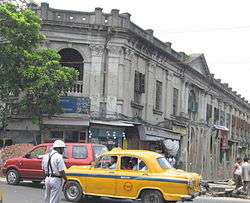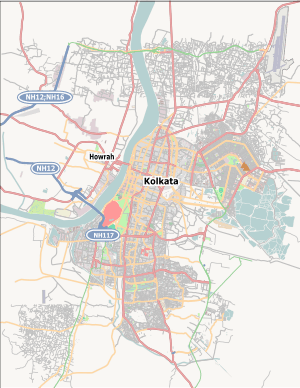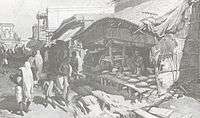Janbazar
| Janbazar | |
|---|---|
| Neighbourhood in Kolkata (Calcutta) | |
 House of Rani Rashmoni | |
 Janbazar Location in Kolkata | |
| Coordinates: 22°34′N 88°21′E / 22.56°N 88.35°ECoordinates: 22°34′N 88°21′E / 22.56°N 88.35°E | |
| Country |
|
| State | West Bengal |
| City | Kolkata |
| District | Kolkata |
| Metro Station | Esplanade |
| Municipal Corporation | Kolkata Municipal Corporation |
| KMC wards | 46, 52 |
| Elevation | 36 ft (11 m) |
| Time zone | UTC+5:30 (IST) |
| PIN | 700017 |
| Area code(s) | +91 33 |
| Lok Sabha constituency | Kolkata Uttar |
| Vidhan Sabha constituency | Chowranghee |

Janbazar is a neighbourhood of central Kolkata, earlier known as Calcutta, in Kolkata district in the Indian state of West Bengal. The two century-old house of Rani Rashmoni, the central attraction in Janbazar, is still used by descendants in the family.
Geography
Janbazar is broadly spread across Ward Nos. 52 and 46 of Kolkata Municipal Corporation.[1]
The road from Chowringhee to Circular Road, about a mile long, was called Jan Bazar Road till the end of the 19th century. It was then renamed Corporation Street[2] and was further renamed Surendranath Banerjee Road.
In olden days, Kolkata streets had oil lamps. Then came the gas lamp and electricity. For sometime there was a tussle between gas lamps and electricity. In 1914, high-powered Keith lamps of 1,000 candle power were fixed on Corporation Street, and Chowringhee Road. Calcutta Electric Supply Corporation bore the cost to demonstrate the advantage of electricity.[3]
Janbazar is served by New Market Police Station of Kolkata Police.[4] The police station is located in Janbazar.
Police district
New Market police station is part of the Central division of Kolkata Police. Located at 133/2 S.N.Banerjee Road, Kolkata-700013, it has jurisdiction over the police district which is bordered on the north from the north-east corner of the junction of Sidhu-Kanu Dahar (old Esplanade Row), Jawaharlal Nehru Road (old Chowringhee Road) and Lenin Sarani (old Dharmatala Street), thence east ward along the northern limit of Lenin Sarani to Rafi Ahmed Kidwai Road (old Wellesly Street), thence crossing Rafi Ahmed Kidwai Road east ward up to the north-east corner of the junction of Lenin Sarani (old Dharmatala Street), Nirmal Chandra Street (old Wellington Street) and Rafi Ahmed Kidwai Road. On the east, it is bordered from the north-east corner of the junction of Lenin Sarani (old Dharmatala Street), Nirmal Chandra Street (old Wellington Street) and Rafi Ahmed Kidwai Road (old Wellesly Street), thence south-ward along the eastern limit of Rafi Ahmed Kidwai Road up to the north-east corner of the junction of Rafi Ahmed Kidwai Road, Mustaque Ahmed Lane (old Marquis Street) and Alimuddin Street. On the south, it is bordered from the north-east corner of the junction of Rafi Ahmed Kidwai Road (old Wellesly Street), Mustaque Ahmed Lane (old Marquis Street) and Alimuddin Street, thence crossing Rafi Ahmed Kidwai Road westward, by the northern limit of Mustaque Ahmed Lane to Mirza Galib Street (old Free School Street) thence crossing Mirza Galib Street westward to the north-west corner of the junction of Mirza Galib Street (old Free School Street) and Mustaque Ahmed Lane, thence southward along the Western limit of Mirza Galib Street to Dr. Md. Ishaque Road (old Kyd Street) up to the north west corner of the junction of Dr. Md. Ishaque Road and Mirza Galib Street, thence westward along the northern limit of Dr. Md. Ishaque Road to Jawaharlal Nehru Road (old Chowringhee Road) up to the north east corner of the junction of Dr. Md. Ishaque Road and Jawaharlal Nehru Road thence crossing Jawaharlal Nehru Road up to the north-west corner of the junction of Dr. Md. Ishaque Road (old Kyd Street), Jawaharlal Nehru Road and Guru Nanak Sarani (old Mayo Road). On the west, it is bordered from the north-west corner of the junction of Dr. Md. Ishaque Road (old Kyd Street), Jawaharlal Nehru Road and Guru Nanak Sarani (old Mayo Road), thence north-ward along the western limit of Jawaharlal Nehru Road up to the south-west corner of the junction of Surendra Nath Banerjee Road, Jawaharlal Nehru Road and Dufferin Road, thence crossing Jawaharlal Nehru Road eastward up to the south-east corner of the junction of Surendra Nath Banerjee Road and Jawaharlal Nehru Road, thence crossing Surendra Nath Banerjee Road northward up to the north-east corner of the junction of Surendra Nath Banerjee Road and Jawaharlal Nehru Road, thence along the eastern limit of Jawaharlal Nehru Road to Lenin Sarani (old Dharmatala Street) up to the north-east corner of the junction of Lenin Sarani, Jawaharlal Nehru Road and Sidhu-Kanu Dahar (old Esplanade Row).[5]
Taltala Women police station covers all police districts under the jurisdiction of the Central division i.e. Bowbazar, Burrabazar, Girish Park, Hare Street, Jorasanko, Muchipara, New Market, Taltala and Posta.[5]
Rani Rashmoni's house
The most famous resident of Janbazar was Rani Rashmoni. Married at the age of 11 to Raj Chandra Das (Marh), the zamindar of Janbazar, she constructed Dakshineswar Kali Temple and engaged in numerous philanthropic activities.[6][7]
What is now known as Rani Rashmoni's house at the crossing of Rani Rashmoni Road and Surendranath Banerjee Road, was initially 70&71 Free School Street. Rani Rashmoni's father-in-law, Pritaram Das, started constructing this house in 1805. It took some 7–8 years to complete construction of the big house.[6]
Jaya Chaliha and Bunny Gupta
Rani Rashmoni had four daughters – Padmamani, Kumari, Karunamoyee and Jagadamba. Mathuramohan Biswas, the husband of Rani Rashmoni's youngest daughter Jagadamba, had always been like a son to Rashmoni which she did not have biologically. The house is now divided into three parts. Jagadamba's descendants live in 13 Rani Rashmoni Road, Kumari's descendants live in 18/3 Surendranath Banerjee Road, and Padmamani's descendants live in 20 Surendranath Banerjee Road.[6]
Rani Rashmoni was a pillar of strength in the male dominated society of mid-nineteenth century. Almost all the rooms of her house are occupied or are still in use. There is a natmandir in front of the verandah, where the famous Durga Puja is held. The family is finding it difficult to maintain the house and although Kolkata Municipal Corporation has declared it a heritage building, it has no funds needed for restoration.[9] Parts of the house are collapsing.[10]
Traffic
The traffic along Surendranath Banerjee Road, across Janbazar, is extremely heavy. Normally, it is a scene of chaos and when a mishap takes place, it is further chaos.[11]
Around Janbazar
 Jan Bazar 2007
Jan Bazar 2007 KMC
KMC_and_S.N.Banerjee_Road_in_Kolkata.jpg) Metropolitan Building at the crossing of Jawaharlal Nehru Road and S.N..Banerjee Road.
Metropolitan Building at the crossing of Jawaharlal Nehru Road and S.N..Banerjee Road.
References
- ↑ Map nos 29 and 33, Detail Maps of 141 Wards of Kolkata, D.R.Publication and Sales Concern, 66 College Street, Kolkata – 700073
- ↑ Cotton, H.E.A., p 248
- ↑ Nair, P. Thankappan, Civic and Public Services in Old Calcutta, in Calcutta, the Living City, Vol. I, p. 231
- ↑ "New Market Police Station". Kolkata Police. Archived from the original on 27 September 2007. Retrieved 10 August 2007.
- 1 2 "Kolkata Police". Central Division. KP. Retrieved 9 March 2018.
- 1 2 3 Bandopadhyay, Debashis, Bonedi Kolkatar Gharbari, (in Bengali), Second impression 2002, pp. 45-6, Ananda Publishers, ISBN 81-7756-158-8
- ↑ Deb, Chitra, The 'Great Houses' of Old Calcutta, in Calcutta, the Living City, Vol. I, p. 61
- ↑ Chaliha, Jaya and Gupta, Bunny, Durga Puja in Calcutta, in Calcutta, the Living City, Vol. II, edited by Sukanta Chaudhuri, first published 1990, 2005 edition, pp. 334-335, Oxford University Press, ISBN 0-19-563697-X.
- ↑ "Pillars of strength, then and now". Kolkata Plus. The Statesman, 7 May 2003. Archived from the original on 29 September 2007. Retrieved 10 August 2007.
- ↑ "Trapped in heritage cave-in - Water tank collapse linked to heavy showers". The Telegraph, 5 October 2006. Retrieved 10 August 2007.
- ↑ "9-yr-old run, mob torches 3 buses". Page One. The Statesman, 2 October 2002. Archived from the original on 26 September 2007. Retrieved 10 August 2007.